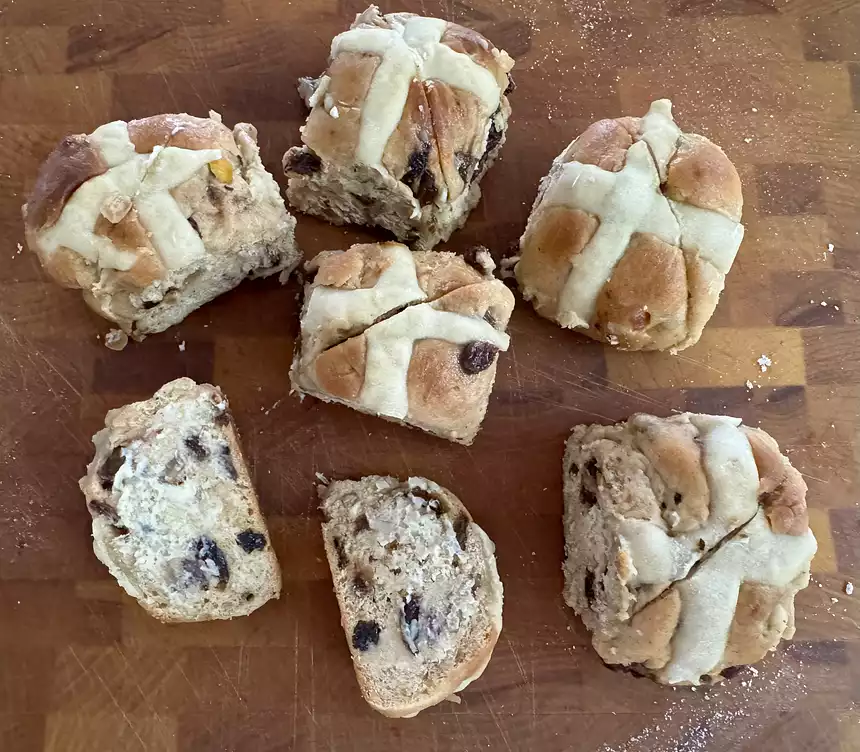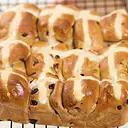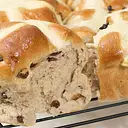Hot Cross Buns are a classic Easter treat, fragrant with warm spices and studded with juicy raisins. Fresh from the oven, their golden crust, tender crumb, and glossy glaze make them irresistible. This recipe yields soft, fluffy buns that are easy to prepare, perfect for a festive breakfast or afternoon tea. With clear steps and pro tips, you’ll create a batch of 12 buns to share with family and friends.
YIELD
12 servingsPREP
15 minCOOK
30 minREADY
1½ hrsChef Tips:
- Yeast Activation: Use a thermometer for milk temperature. Too hot (>120°F / 50°C) kills yeast; too cold (<100°F / 38°C) slows activation.
- Warm Rising Spot: If your kitchen is cool, place the dough in a turned-off oven with a bowl of hot water to create a warm environment.
- Cross Consistency: Test pipe the paste on a plate first. It should hold its shape without running.
- Storage: Store buns in an airtight container for up to 2 days. Reheat at 300°F (150°C) for 5 minutes to refresh. Freeze unglazed buns for up to 1 month; thaw and glaze before serving.
- Make Ahead: Prepare dough through step 5, cover, and refrigerate overnight for the first rise. Let come to room temperature before proceeding.
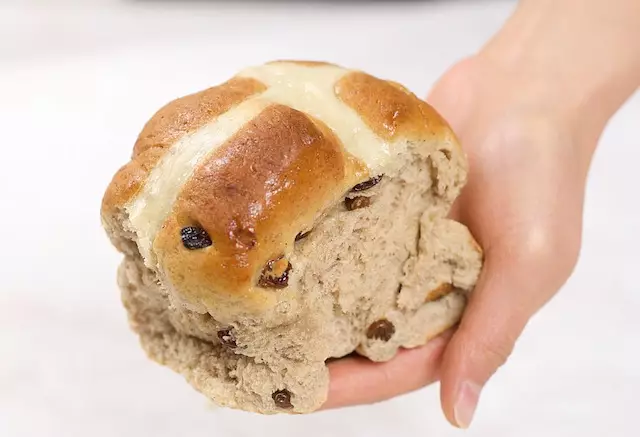
Optional Variations
- Fruit Swap: Replace raisins with currants, dried cranberries, or chopped dried apricots for a twist.
- Citrus Zest: Add 1 tablespoon orange or lemon zest to the dough for a bright flavor.
- Spice Boost: Increase cinnamon to 1.5 teaspoons or add ¼ teaspoon nutmeg for deeper warmth.
- Glaze Alternative: Swap gelatin glaze for a simple syrup (2 tbsp sugar + 2 tbsp water, boiled until dissolved) for a vegetarian option.
- Whole Wheat Option: Substitute 1 cup all-purpose flour with whole wheat flour for a heartier texture, but expect slightly denser buns.
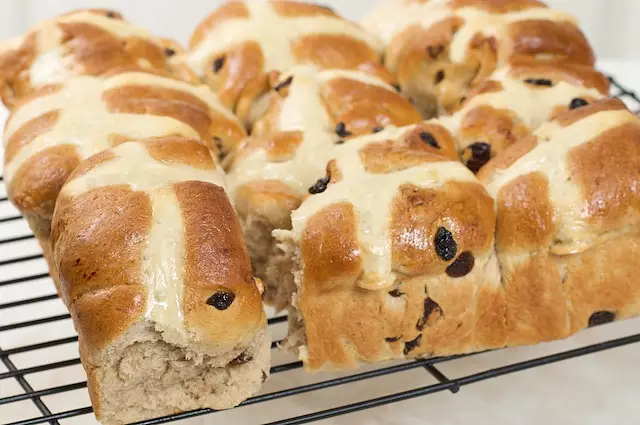
Ingredients
For the crosses
Glaze
Directions
- Activate Yeast: In a small bowl, combine yeast, ¼ cup powdered sugar, and lukewarm milk. Stir gently and let sit for 5–10 minutes until frothy with bubbles on the surface. (If no bubbles form, yeast may be inactive; start over with fresh yeast.)
- Make Dough: In a large mixing bowl, whisk together flour, salt, mixed spice, and cinnamon. Make a well in the center and add melted butter, beaten egg, raisins, and the frothy yeast mixture. Stir with a wooden spoon or dough scraper until a sticky dough forms.
- Knead Dough: Turn dough onto a lightly floured surface. Knead for 8–10 minutes, adding minimal flour as needed, until smooth and elastic. (Dough should feel slightly tacky but spring back when pressed.)
- First Rise: Shape dough into a ball and place in a lightly oiled bowl. Cover with a clean tea towel or plastic wrap. Let rise in a warm, draft-free place (75–85°F / 24–29°C) for 45–60 minutes, or until doubled in size.
- Shape Buns: Gently punch down dough to deflate. Divide into 12 equal pieces (use a scale for precision, ~80g each). Roll each piece into a smooth ball. Arrange buns in a 9×9-inch (23cm) square baking pan lined with parchment paper, leaving small gaps between them.
- Second Rise: Cover with a tea towel and let rise in a warm place for 25–30 minutes, or until buns are puffy and touching each other.
- Preheat Oven: Preheat to 390°F (200°C), conventional setting (adjust to 375°F / 190°C for fan-forced ovens).
- Prepare Crosses: Mix ½ cup flour with ⅓ cup water to form a thick, smooth paste. Add water 1 teaspoon at a time if too thick. Transfer to a piping bag or a ziplock bag with a small corner snipped off. Pipe crosses onto the risen buns.
- Bake: Bake for 25–30 minutes, or until golden brown and buns sound hollow when tapped. (Internal temperature should reach 190°F / 88°C.)
- Glaze: While buns bake, combine sugar, gelatin, and ¼ cup water in a small saucepan. Heat over medium, stirring until fully dissolved, about 2 minutes. Brush warm buns with glaze immediately after baking.
- Serve: Cool slightly in the pan, then serve warm with butter or enjoy at room temperature. Makes 12 buns.
Notes
Large buns
These make large buns. Often I will divide into 18 equal balls and use a 13×9 baking dish for smaller buns that are a better serving size in my opinion.
Fixing Dense Buns
Dense buns can result from insufficient kneading, under- or over-proofing, or heavy dough handling. To make buns fluffier:
- Optional Adjustment: During kneading (step 3), ensure dough reaches the “windowpane stage” (a small piece stretched thin should be translucent without tearing). This develops gluten for a lighter crumb.
- Tip: Avoid adding excess flour while kneading, as it can weigh down the dough. Use a bench scraper to handle stickiness.
- Tip: For the first rise, check dough by pressing lightly; it should hold a fingerprint but slowly spring back. If over-proofed (dough collapses), buns may be dense.
- Optional Technique: After shaping buns (step 5), gently stretch and fold each piece before rolling into balls to create surface tension, which helps with rise and fluffiness.
Comments
